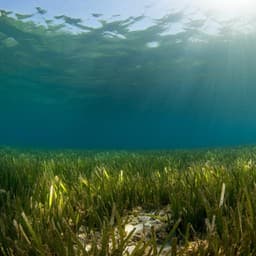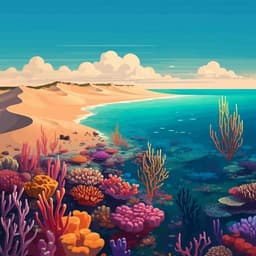
Environmental Studies and Forestry
Seagrass meadows are important sources of reef island-building sediment
H. K. East, J. A. Johnson, et al.
This groundbreaking research conducted by Holly K. East, Jamie A. Johnson, Chris T. Perry, Grace Finlay, Azim Musthag, Hussein Zahir, and Matthew Floyd reveals the vital role of seagrass meadows in producing sediment for reef island building. With significant annual carbonate sediment production, this study underscores the importance of seagrass conservation in protecting vulnerable atoll nations.
Playback language: English
Introduction
The survival of low-lying coral reef islands, crucial for the over 700,000 people living in atoll nations, is threatened by rising sea levels and flooding. These islands are entirely composed of carbonate (CaCO3) sediments produced by marine organisms. Changes in marine ecology directly impact sediment production rates and characteristics (grain size, composition), affecting island resilience. Predicting the future of these islands requires a thorough understanding of marine carbonate sediment production. While the role of organisms like parrotfish in producing reef island-building sediments is increasingly understood, the contribution of seagrass meadows has been largely ignored. Seagrass meadows are widespread around many low-lying reef islands and are known carbonate sources. A key mechanism of seagrass sediment production involves leaf epibiota: carbonate-producing organisms (foraminifera, molluscs, serpulids, crustose coralline algae) that live on seagrass leaves. These organisms contribute sediment when dislodged or when the leaf dies. While mud-sized sediment is a common product, sand- and gravel-sized sediments are crucial for reef island building due to their longer residence time on reef platforms. Existing research highlights the significance of sand-sized sediment for island development and resilience, yet the capacity of seagrass meadows (via epibiont production) to produce these sediments remains unquantified. This knowledge gap is particularly concerning in regions like the Maldives, where seagrass is actively removed for tourism purposes, highlighting the critical need for quantitative data to assess the impact of seagrass removal on island sustainability. This study investigates the potential role of seagrass meadows as sources of sand-sized sediments suitable for reef island building.
Literature Review
Previous research has established seagrass meadows as sources of carbonate sediments, but these studies often focused on total carbonate production or mud-sized fractions, overlooking the importance of sand-sized sediments for reef island building. Studies on parrotfish have shown their significant contribution to island-building sediment production in the Maldives and other regions. However, the role of seagrass epibionts in producing sand-sized carbonate sediment in the context of reef island sediment supply has remained largely unexplored, despite the recognition that seagrasses are widespread around reef islands and are significant carbonate sources. Existing data on seagrass sediment production often focuses on total carbonate production or smaller sediment fractions, neglecting the critical role of sand-sized sediments in island building processes. Therefore, this study addresses this significant knowledge gap by specifically quantifying the production of sand-sized sediment by seagrass epibionts.
Methodology
This study combined field data, high-resolution satellite imagery, and sedimentological analyses from a 1.1 km² seagrass meadow off Faathihutta island, Huvadhoo Atoll, Maldives. The site was chosen as representative of seagrass meadows in the atoll. The study area was divided into four zones (one split into two sub-zones) based on seagrass leaf density, percentage cover, and species composition (*Thalassodendron ciliatum* and *Thalassia hemprichii*). PlanetScope satellite imagery (3 m² resolution) was used for unsupervised classification of seagrass zones, with ground truthing to validate the classification (98% accuracy). Sediment production rates were calculated using the weight loss after acidification method. This involved analyzing the mass of carbonate epibionts per seagrass leaf for each species within each zone. Species-specific leaf densities and annual leaf turnover rates were incorporated to estimate carbonate production rates (kg CaCO3 m⁻² yr⁻¹). The longest published turnover rates were used to provide conservative estimates. To assess the proportion of sand-sized sediment, bulk seagrass samples were collected, epibionts scraped from leaves, organic matter removed, and grain size distributions analyzed using a laser particle sizer (Malvern Mastersizer 2000). To simulate wave action, samples were agitated in water for 21 days, and grain size re-analyzed. Pre- and post-agitation grain size distributions were compared to determine the proportion of sand-sized sediment. Species-level sediment production rates were then summed across zones, weighted by zone area, to calculate total and sand-sized sediment production. Statistical analyses (ANOVA and Kruskal–Wallis tests) were conducted to identify significant differences between zones and species. Error propagation was used to estimate cumulative errors.
Key Findings
The study found a total seagrass epibiont sediment production of 762,000 ± 90,000 kg CaCO3 per year across the 1.1 km² site. After 21 days of simulated wave action, 482,000 ± 23,000 kg CaCO3 per year was estimated as sand-sized sediment suitable for reef island building. This equates to the approximate volume of the adjacent island over an ~18-year period. Production rates varied between zones (0.22 ± 0.13 kg CaCO3 m⁻² yr⁻¹ to 0.86 ± 0.21 kg CaCO3 m⁻² yr⁻¹), reflecting differences in seagrass leaf densities, species abundance, and turnover rates. The mass of epibionts was significantly higher on *T. ciliatum* than *T. hemprichii* leaves. Sediment mass per leaf was significantly higher in Zone 2 (continuous seagrass cover), possibly due to increased photosynthetic activity or wave energy baffling. Pre-agitation grain size distributions were highly variable, while post-agitation distributions were strikingly similar, suggesting sediments reached their end-point grain size. The high proportion of post-agitation sand-sized sediment (61 ± 10%) demonstrates the significant role of seagrass in generating geomorphically important sediment. The composition of upper sedimentary horizons of nearby islands supports the findings, showing significant contributions from benthic foraminifera, CCA, and molluscs. The authors note that their estimates are likely underestimates due to factors such as other sediment-producing organisms, parrotfish activity, and exclusion of gravel-sized sediments from analysis. Upscaling the findings to a national level suggests Maldivian seagrass meadows produce approximately 81,183 ± 18,421 tonnes of CaCO3 per year, with 63% being sand-sized material. However, this national-scale estimate doesn't account for spatial variability in environmental conditions.
Discussion
The findings demonstrate that seagrass meadows are significant producers of geomorphically important carbonate sediment suitable for reef island building, adding to the previously recognized ecosystem services of blue carbon storage and habitat provision. The study's results highlight a previously undervalued ecosystem service of seagrass meadows. The production of substantial volumes of sand-sized sediments suitable for reef island building enhances the physical resilience of adjacent coastlines to erosion. This has significant implications for coastal management and conservation efforts, especially considering the threats faced by seagrass meadows (direct removal, pollution, coastal construction, climate change impacts). While seagrass meadows face climate change threats (storms, rising temperatures, sea-level rise, ocean acidification), the study suggests that the current decline in coral health in the Maldives may be more pronounced than the decline in seagrass. The study emphasizes the importance of considering seagrass sediment production in coastal management plans, particularly for atoll nations. The reliance of atoll islands on sediment from carbonate-producing organisms underscores the critical role of seagrass meadows in maintaining island resilience, especially given concerns about declining coral health. The study advocates for seagrass conservation as a nature-based solution to increase shoreline resilience and reef island stability against sea-level rise and coastal erosion.
Conclusion
This study provides the first estimates of sediment production by seagrass epibionts in a reef island sediment supply context, showing that seagrasses generate substantial quantities of carbonate sediment suitable for island building. This sediment production enhances reef island resilience to climate change impacts. The production of reef island-building sediments represents a valuable, yet under-recognized, ecosystem service of seagrass meadows. While seagrass conservation efforts often focus on blue carbon storage and biodiversity, this study adds a compelling geomorphic argument for conservation by highlighting the significance of sediment production in maintaining island stability. Future research should focus on site-specific seagrass turnover rates, spatial variability in sediment production across broader regions, and the combined influence of seagrass and other organisms on island-building processes.
Limitations
The study acknowledges that the sediment production estimates are likely underestimates due to the exclusion of sediment from other organisms (infaunal and epifaunal organisms, parrotfish), and the use of conservative turnover rates. The national-scale upscaling doesn't account for spatial variability in environmental conditions, seagrass leaf densities, and species composition. Furthermore, while the 21-day agitation period simulates wave action, the actual rates of sediment breakdown in marine environments may vary. The study primarily focuses on oceanward seagrass meadows; lagoonward meadows may also contribute significantly to sediment production. Future work should expand on these areas to further refine estimates and improve the understanding of seagrass contributions to island building.
Related Publications
Explore these studies to deepen your understanding of the subject.







